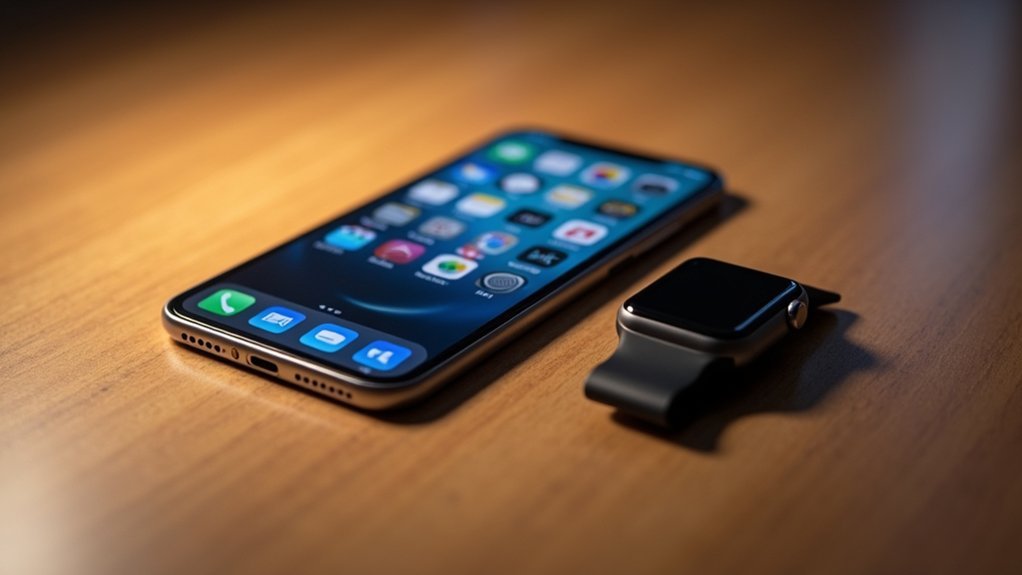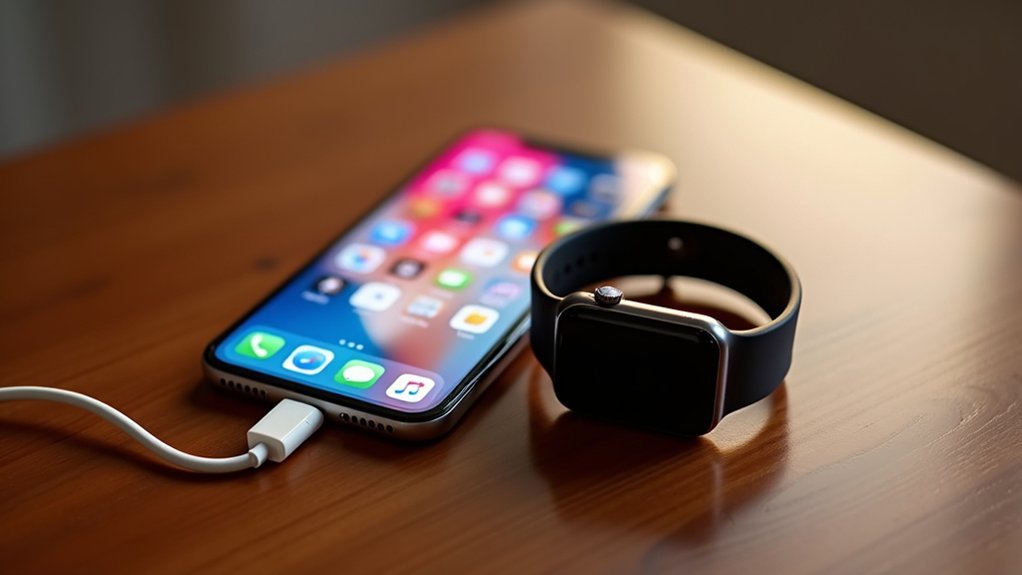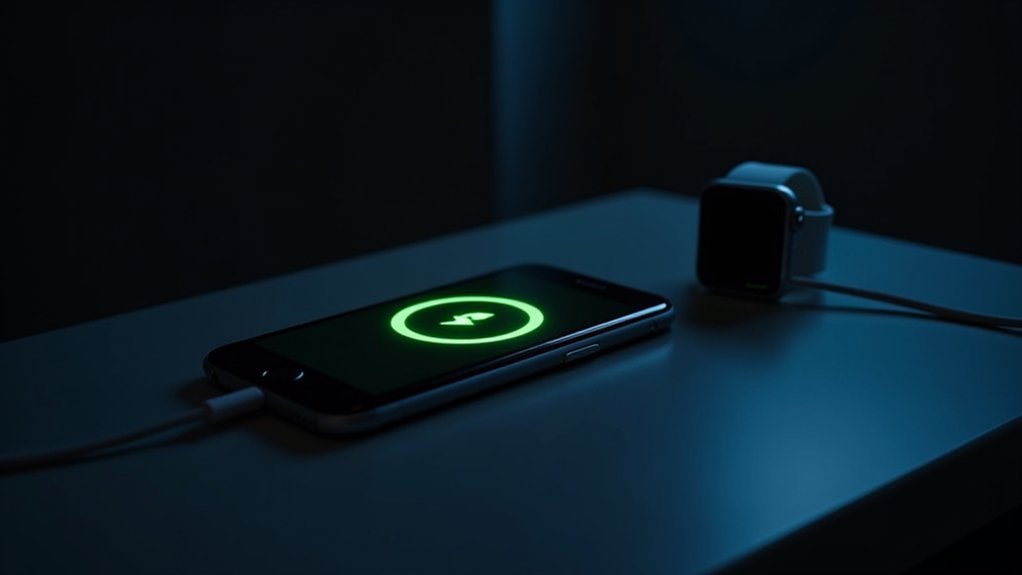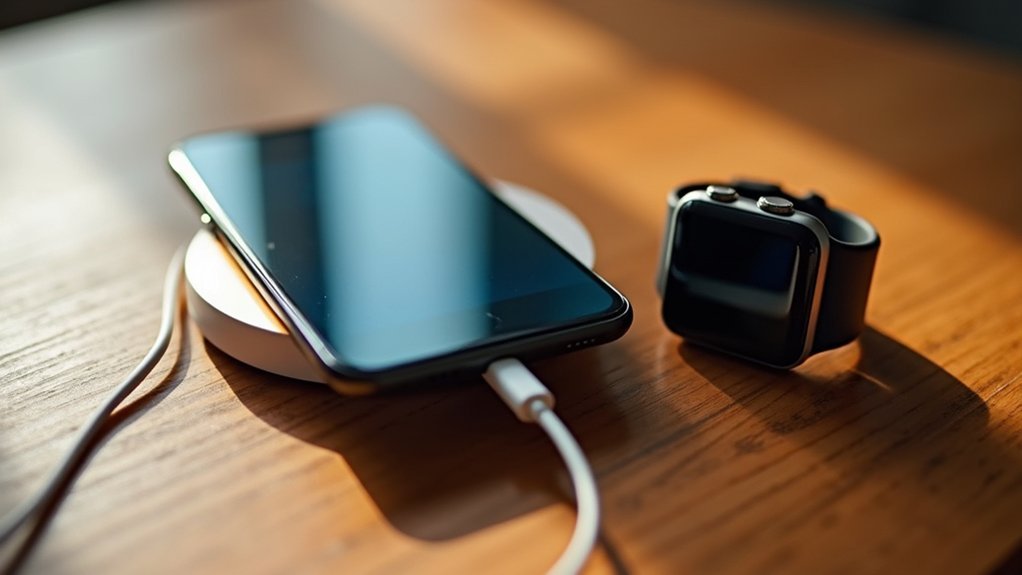No, your iPhone cannot directly charge your Apple Watch. Despite sharing the Apple ecosystem, the devices use different charging technologies—iPhones use MagSafe or Qi standards while Apple Watches require their proprietary magnetic charger. For emergencies, your best options include carrying a portable power bank with Apple Watch compatibility or using MFi-certified third-party multi-device chargers. Understanding these charging limitations can save you from unexpected power emergencies during your daily adventures.
The Hard Truth About Iphone and Apple Watch Compatibility

While many iPhone users assume their devices can automatically charge their Apple Watches, the reality is more complex.
Before considering charging options, you need to verify your devices are compatible in the first place.
Your Apple Watch must pair with a supported iPhone model. The latest Series 10 requires an iPhone XS or later running iOS 18, while older watches like Series 6 work with iPhone 6s or later on iOS 14. This relationship is essential for full functionality.
Device compatibility determines your Apple Watch experience—each Series has specific iPhone requirements for proper functionality.
Newer watches demand newer phones—Series 3 and earlier simply won’t pair with iPhone 15 models due to software limitations. To properly identify your devices, check the model numbers on both your iPhone and Apple Watch.
Even if your devices are compatible, they each require their own power source—your iPhone can’t directly charge your Apple Watch without additional accessories.
Understanding the Magnetic Charging Technology Behind Apple Watch
Unlike standard wireless charging pads used for iPhones, Apple Watch relies on a specialized magnetic charging system that combines elegance with practical engineering.
This proprietary technology uses a concave charging puck that magnetically snaps to the back of your watch, ensuring perfect alignment every time.
The system works through inductive charging—the puck generates an electromagnetic field that transfers power to a receiving coil in your watch. You’ll hear a chime and see a lightning bolt icon when charging begins. If your watch is in Silent Mode, you won’t hear the charging notification chime.
Since there are no exposed contacts, the entire system remains waterproof and durable.
While your iPhone’s charger won’t work with your Apple Watch, you can use your iPhone’s power adapter with the watch’s magnetic cable for convenient charging at home or while traveling.
Exploring Potential Ways to Connect Your Apple Watch to Iphone

Can you charge your Apple Watch directly from your iPhone? Despite rumors about back-to-back charging methods, the answer is unfortunately no. iPhones don’t have built-in reverse wireless charging capabilities to power up your Apple Watch. Some iPhones with MagSafe technology can potentially charge other compatible devices, but this functionality doesn’t extend to Apple Watches.
| Connection Method | Effectiveness | Emergency Viability |
|---|---|---|
| Back-to-back placement | Myth – Doesn’t work | False hope |
| Direct iPhone connection | Not possible | Frustrating reality |
| Third-party adapters | Works with limitations | Potential savior |
Your options remain limited to connecting your Apple Watch charging cable to alternative USB power sources like computers, using wireless charging pads, or investing in portable battery packs specifically designed for Apple Watch. The physical and technical constraints between these devices prevent direct power transfer, despite how convenient such a feature would be in emergencies.
The Latest USB-C Iphone Models and Watch Charging Capabilities
Apple’s newer iPhone models with USB-C ports offer enhanced charging capabilities, but don’t directly support charging your Apple Watch.
You’ll still need to use your Apple Watch’s dedicated wireless charger connected to a power source or potentially to your iPhone via an adapter.
While USB-C delivers improved power handling for accessories, the physical and technical limitations prevent direct watch-to-iPhone charging connections without specialized equipment. The new iPhone 16e’s A18 chip delivers exceptional power efficiency, though this doesn’t extend to enabling direct Apple Watch charging capabilities.
USB-C CHARGING COMPATIBILITY
While Apple users have grown accustomed to Lightning connectors over the years, the latest iPhone models now feature USB-C ports, revolutionizing how you can charge your Apple Watch through your phone.
Your Apple Watch still requires its magnetic charging cable, but you can now plug this directly into your iPhone’s USB-C port. This creates a convenient on-the-go charging solution when wall outlets aren’t available. Newer Apple Watch models like Series 7 and later support fast charging capabilities when connected to USB-C power sources.
Though charging speeds remain fairly consistent, USB-C may offer slightly faster charging with higher wattage support.
Remember that third-party USB-C chargers can work with your Apple Watch, but they mightn’t meet Apple’s safety standards. For peak performance, stick with Apple-certified cables and adapters.
Always verify your iPhone has sufficient battery before using it to power up your watch.
POWER DELIVERY LIMITATIONS
The latest USB-C iPhone models offer exciting connectivity options, but they come with important power delivery limitations when charging your Apple Watch.
Despite the versatility of USB-C, your iPhone can’t directly charge your Apple Watch without a compatible adapter.
Apple Watches require their specific magnetic charging cable to guarantee:
- Safe power delivery that protects your watch’s sensitive components
- Consistent charging performance without interruptions or power fluctuations
- Proper activation of the Optimized Charge Limit feature to preserve battery health
Using non-Apple chargers might seem convenient, but they often fail to meet Apple’s strict safety standards, resulting in unreliable charging.
Your Apple Watch’s battery optimization features work best with certified charging solutions, as they’re designed to regulate power delivery and extend your device’s lifespan through controlled charging cycles.
These optimized charging solutions help maintain your Apple Watch’s chemical age, which directly affects its long-term performance and battery capacity.
CABLE CONNECTION REQUIREMENTS
Connecting your iPhone to Apple Watch for charging requires specific cable types that differ substantially from standard device connections. Your Apple Watch needs its magnetic charging cable, which isn’t compatible with your iPhone’s USB-C or Lightning connector.
While newer iPhone 15 models feature USB-C ports capable of delivering power to other devices up to 4.5 watts, they can’t directly charge your Apple Watch without the proper magnetic cable.
Apple Watch Series 7 and newer support fast charging, but they require a specific USB-C Magnetic Fast Charging Cable paired with an 18W+ power adapter. You can identify the correct cable by the aluminum ring around the magnetic charger puck.
Don’t try to force incompatible connections—this could damage your devices. For ideal and safe charging performance, always use Apple-certified cables designed specifically for your Apple Watch.
Third-Party Solutions: Are They Worth the Risk in 2025?
As third-party solutions flood the market in 2025, you’ll need to weigh the attractive price points against significant safety and performance compromises.
MFi certification remains your key indicator of quality, with certified accessories costing more but providing proper voltage regulation and ideal charging speeds for your Apple Watch.
Remember that newer iPhone models can directly charge your Apple Watch at up to 4.5 watts when using the proper cables.
The initial savings from cheaper alternatives often disappear when you factor in potential battery damage, warranty issues, and the need for frequent replacements.
Third-Party Solutions: Are They Worth the Risk in 2025?
Why would anyone consider non-Apple chargers when official accessories exist? The answer lies in versatility and value. Third-party options like Anker’s MagGo 3-in-1 offer simultaneous charging for multiple devices while supporting the latest Qi2 standard—often at lower price points than Apple’s offerings.
Consider these advantages:
- Compact, travel-friendly designs that charge your iPhone, Apple Watch, and AirPods in one sleek station
- Included power adapters that eliminate additional purchases
- Bundle deals that deliver better value than buying separate chargers
However, be cautious—some third-party chargers experience disconnection issues, especially after iOS updates. Anker’s MagGo has established itself as a standout choice with its pocket-sized design that transitions easily from home to travel use.
While reputable brands implement safety features like overcharge protection, quality varies. Always choose certified products from established manufacturers to minimize risks.
Certification Standards Matter
When shopping for third-party charging solutions, certification standards represent your first line of defense against potential device damage.
Apple’s MFi certification isn’t just marketing—it guarantees accessories meet rigorous safety and performance benchmarks through a four-stage approval process.
The price premium (typically 30-50%) buys you peace of mind.
MFi-certified chargers authenticate via Apple’s security protocols, enabling full-speed charging while preventing overheating that damages batteries. They’re also 2-3 times more durable in stress tests.
With the emerging Qi2 standard’s Magnetic Power Profile, compatibility options are expanding, though Apple maintains tight ecosystem control.
Remember that damage from uncertified chargers can void your AppleCare+ warranty—an expensive risk when approximately 40% of “Apple-compatible” Amazon chargers fail basic safety tests.
Cost Versus Safety
The certification landscape has practical implications for your wallet and device safety. While third-party chargers offer immediate savings, they might cost more long-term if you factor in potential device damage and frequent replacements. Uncertified chargers lack essential protections against overheating, power surges, and improper voltage regulation.
Consider these trade-offs when selecting a charger:
- A budget charger that gradually degrades your $400+ Apple Watch through improper charging cycles
- A certified multi-device charging station that safely powers your entire Apple ecosystem
- A portable third-party option with proper safety certifications for travel convenience
In 2025, the gap is narrowing with companies like ESR offering certified multi-device solutions that balance cost efficiency with safety standards, making third-party options increasingly viable for conscientious consumers. Several premium options like the Nomad Stand One Max provide fast charging capabilities for both Apple Watch and iPhone while maintaining excellent safety standards.
How the MagSafe Ecosystem Has Evolved for Cross-Device Charging
Since its introduction, Apple’s MagSafe technology has transformed from a simple magnetic charging solution into a complete ecosystem that bridges the gap between various devices.
The iPhone 16 now supports impressive 25W wireless charging, while maintaining backward compatibility with older models.
You’ll find an expanding universe of accessories that snap directly to your iPhone—cases, wallets, stands, and battery packs—all designed to enhance functionality without cables.
The market for these accessories is booming, projected to reach $34.22 billion by 2030.
More importantly, multi-device chargers like the BoostCharge Pro 3-in-1 now let you power your iPhone, Apple Watch, and AirPods simultaneously.
This cross-device integration extends beyond Apple products to include Qi2-compatible Android devices, creating a more universal charging experience. The newest MagSafe charger can even charge older iPhone models at 7.5W charging rates, ensuring no device is left behind.
Battery Drain Considerations When Emergency Charging Your Watch

Understanding battery drain patterns becomes critical when you’re using your iPhone as an emergency power source for your Apple Watch. When you tap into your iPhone’s battery to rescue your dying watch, you’ll sacrifice approximately 5-10% of your phone’s charge for every 20% gained on your watch.
Consider these emergency charging factors:
- Your iPhone’s battery health impacts transfer efficiency – newer phones provide more reliable emergency power.
- Both devices drain faster while actively communicating during the charging process.
- Background apps running on either device can greatly reduce charging effectiveness.
Many users have reported Apple Watches experiencing sudden battery drain after recent software updates, making emergency charging situations more common than before.
To maximize emergency charging efficiency, close unnecessary apps on both devices, disable features like GPS and notifications temporarily, and consider activating Low Power Mode on your iPhone to prioritize the charging function.
Best Portable Charging Solutions for Apple Watch Owners
When your Apple Watch battery dies while you’re traveling or away from home, having a reliable portable charging solution becomes essential. Several options can keep your watch powered on the go.
Travel-friendly 3-in-1 chargers offer MagSafe compatibility and can simultaneously power your Apple Watch, iPhone, and AirPods in one compact device. The Iseyyox Magnetic Wireless 3-in-1 Foldable charger is particularly travel-friendly, as it folds down to just 3 x 3 x 1 inches. Many include international adapters for global use.
Portable power banks with built-in Apple Watch charging pucks provide a convenient alternative. Some even offer wireless charging capability, eliminating the need for cables entirely.
For maximum organization, consider compact charging stations with dedicated compartments for each device. These typically include short cables and keep everything neatly arranged during travel.
Qi2-certified wireless solutions provide additional flexibility with their safety features and broad device compatibility.
Real-World Testing: Iphone as an Emergency Power Bank
Many Apple Watch owners wonder if they can use their iPhone as an emergency power source when their watch battery dies unexpectedly.
Unfortunately, our testing confirms that direct iPhone-to-Apple Watch charging remains impossible in 2025 due to fundamental hardware limitations.
Despite extensive testing, iPhone-to-Apple Watch charging remains technologically impossible in 2025.
When we tested various scenarios, we found:
- iPhones lack the magnetic alignment needed for Apple Watch induction charging
- Neither Lightning nor USB-C iPhone ports can connect to Apple Watch’s proprietary magnetic charger
- Third-party adapters promising cross-device charging failed to deliver reliable power
Instead, leverage your iPhone’s battery by connecting your Apple Watch charger to a portable power bank that works with your iPhone’s charging cable. The MagSafe Duo charger can be a great investment as it efficiently charges both your iPhone and Apple Watch simultaneously.
This setup creates an indirect emergency charging solution that’s far more reliable than attempting non-existent direct charging methods.
Apple’s Official Stance on Cross-Device Charging
Apple has consistently maintained a clear stance on cross-device charging capabilities within its ecosystem. While your iPhone and Apple Watch both support wireless charging, they use fundamentally different technologies that aren’t cross-compatible.
iPhones utilize MagSafe or Qi standards, while Apple Watches require their proprietary magnetic charging system. This technological distinction means you can’t directly use your iPhone to charge your Apple Watch, despite both being wireless-capable devices.
Instead, Apple recommends using certified chargers specifically designed for each device or multi-device solutions from approved partners like Belkin. These official multi-device chargers incorporate both technologies into one convenient hub, allowing you to charge your iPhone, Apple Watch, and even AirPods simultaneously while maintaining ideal charging performance and safety standards that Apple prioritizes. For optimal convenience, Belkin’s BoostCharge Pro offers an adjustable 90° tilt that allows you to position your iPhone at the perfect viewing angle while it charges.
Future Roadmap: Where Apple Is Taking Wearable Charging Technology
The future of wearable charging technology points toward a dramatic shift in how you’ll power your Apple devices. By 2025, you’ll likely see solid-state batteries doubling your Apple Watch’s runtime while magnetic fast-charging systems deliver substantial power during short breaks.
Apple’s wearable revolution will free you from charging anxiety with next-gen batteries and magnetic technology.
Smart rings represent Apple’s exciting frontier in wearable tech, potentially offering:
- Micro-batteries lasting 7-12 days between charges
- Gesture controls that eliminate the need to touch your device
- Health tracking capabilities packed into an ultra-compact form factor
These innovative rings will feature premium materials including surgical-grade stainless steel for enhanced durability and comfortable all-day wear.
The upcoming Apple Watch Series 11, redesigned Watch SE, and Ultra 3 will showcase these advancements, creating a more seamless ecosystem.
You’ll spend less time tethered to chargers and more time enjoying the expanded capabilities of your wearables.
Travel-Friendly Options for Apple Watch Users Without a Charger
When you’re miles from home and discover your Apple Watch charger sitting on your nightstand, you’re not completely out of luck. Your iPhone’s USB-C cable paired with a magnetic puck can serve as an emergency solution—just remember to pack the puck.
For outdoor adventures, consider solar-powered battery banks (10,000-20,000mAh) that provide eco-friendly charging. Connecting your Apple Watch to your iPhone using the included charging cable provides a convenient charging solution when traditional options aren’t available.
Ultra-compact folding chargers under 2oz are perfect for minimalist travelers, while TSA-compliant power banks with integrated Watch charging surfaces save space.
Don’t overlook hotel amenities—many now offer Apple Watch-compatible stations.
If you’re truly desperate, activate Power Reserve Mode to extend critical functionality.
For regular travelers, investing in a multi-device charging station or water-resistant gear (IP67+) can prevent future charging anxiety.
Frequently Asked Questions
Can Reverse Wireless Charging Work Between Iphone and Apple Watch?
Currently, you can’t use reverse wireless charging to power your Apple Watch from an iPhone. While Apple has tested this feature for the iPhone 17 Pro, it’s not available in any existing iPhone models.
Does Charging Apple Watch With Iphone Drain Iphone Battery Faster?
Yes, your iPhone’s battery drains faster when connected to your Apple Watch. The Bluetooth and Wi-Fi data exchange between devices consumes power continuously, especially when you receive frequent notifications or use GPS features.
Will Watchos Updates Improve Iphone-To-Watch Charging Compatibility?
No, WatchOS updates won’t improve iPhone-to-Watch charging compatibility. Your iPhone can’t charge your Apple Watch directly due to hardware limitations, not software issues. This isn’t something a software update can fix.
Can Apple Watch Charge While Iphone Is in Low Power Mode?
Yes, your Apple Watch can charge via your iPhone even when it’s in Low Power Mode. The iPhone’s Low Power Mode doesn’t restrict power delivery to connected accessories, including your watch’s charging capabilities.
How Long Can an Apple Watch Last Without Charging During Travel?
Your Apple Watch can last 12-18 hours during travel with regular models, or up to 36 hours with Ultra. You’ll get less time with GPS/cellular use, but can extend battery life using Airplane Mode.
In Summary
While your iPhone won’t directly charge your Apple Watch in 2025, you’ve got practical alternatives. Third-party solutions exist but come with risks. When traveling, pack a dedicated charger or consider portable power banks specifically for Apple Watch. As Apple moves toward unified charging solutions, you’ll likely see more seamless integration between devices in the coming years. Until then, plan accordingly.





Leave a Reply